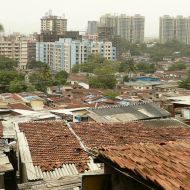Can Global South Cities Leapfrog the West’s Energy-Intensive Architecture?

Hermetically sealed high-rises are becoming more common in Accra, a departure from the air-flow-enabling construction of the past. Photo credit: Moises Nazario
If you look at where the Informal City Dialogues are taking place, they’re conspicuously close to the equator. Here in Accra, we’re just five degrees north of it; Nairobi is one degree south. Beyond rapid urbanization, cities like Accra and Lagos, Mumbai and Chennai have their climate in common — they’re all really, really hot.
It’s 90 degrees Fahrenheit (32 Celsius) in Accra today, as it will be for the next month. At night, the temperature barely drops below 80. It’s not a dry heat either, it’s a muggy, humid heat that makes you sweat the second you’re in the sun.
Many of the old structures built in Accra were designed to encourage cross ventilation and shelter from the sun. Trees were planted for shade and verandas kept people cool. Mud and earth have long been used because those materials are plentiful, cheap and naturally stay cool; small innovations, like jalousie windows, which allow in cooling breezes but keep out rain, are typical throughout older buildings.
But as Accra grows upward and outward, it doesn’t seem like the old ways of building are being translated into new construction. From what I can tell, all the tall buildings are made from concrete, windows are inoperable, and the air-conditioning is always on full blast. When the power goes out (as it does frequently due to energy rationing), these buildings rely on generators to keep the lights on and the air flowing.
As the world struggles with climate change, it would seem that these cities have the opportunity to learn from the West’s mistakes. They should look at Houston and Phoenix, places where people can’t live without the air-conditioning that cools their homes and offices, or the private cars that keep their passengers climate controlled. In those cities, people spend most of the daylight hours inside, reducing opportunities for public interaction. The energy-intensive lifestyle is also heavy on carbon emissions.
If Africa can leapfrog the West’s telecom infrastructure, it should do the same in terms of architecture and urban planning. These cities have the opportunity to develop sustainable architecture and planning that keeps energy use low and elevates public interaction — all the while keeping people cool.
For young, emerging architects, working with traditional materials is in vogue. Francis Kere’s primary school in Burkina Faso and MASS Design Group’s work in Rwanda use local, natural materials. The next challenge then is to figure out how these examples translate to urban contexts where the new multi-story buildings are typically shopping malls, apartment complexes and hotels.
Sustainable architecture and design that responds to the climate must be a larger part of the discussion about rapid urbanization, as it will affect the quality of so many cities growing near the equator. The social and economic concerns that are visible walking down the street in Accra will only be exacerbated if the buildings housing people are economically and environmentally unsustainable.






